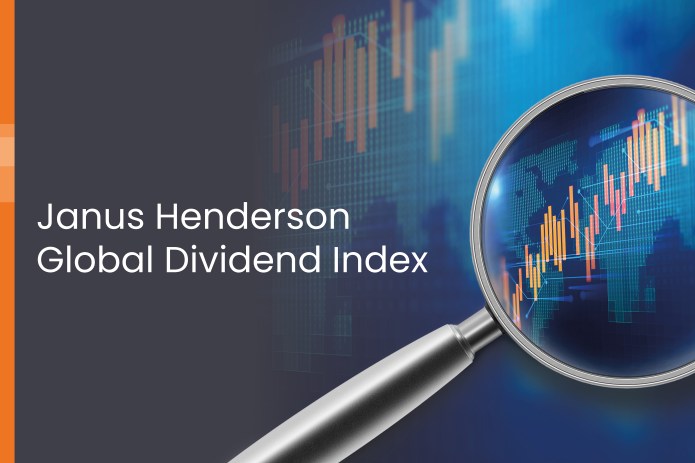Global dividends rose to a record $1.66 trillion in 2023
According to the latest Janus Henderson Global Dividend Index, global dividends rose to a record $1.66 trillion in 2023, up 5.0% on an underlying basis. The year ended on a particularly positive note, with Q4 dividends rising 7.2% on an underlying basis, thanks to strength in Europe, the UK and Japan.

30 minute read
Key takeaways:
- 22 countries saw record payouts in 2023, including the U.S., France, Germany, Italy, Canada, Mexico and Indonesia, while 86% of companies globally increased dividends or held them steady.
- Large cuts from just five companies reduced the global underlying growth rate by two percentage points, masking encouraging broad-based growth in many parts of the world.
- Banks delivered record dividends in 2023 and contributed half the world’s dividend growth, although the positive impact from higher banking dividends was almost entirely offset by cuts from the mining sector.
The Janus Henderson Global Dividend Index (JHGDI) is a quarterly, long-term study into global dividend trends. The index measures the progress global firms are making in paying their investors an income on their capital.
Global dividends rose to a record $1.66 trillion in 2023, up by 5.0% on an underlying basis, according to the latest Janus Henderson Global Dividend Index. The year ended on a particularly positive note, with Q4 dividends rising 7.2% on an underlying basis, thanks to strength in Europe, the UK and Japan.
Banks were the key driver of dividend growth
The banking sector delivered record payouts in 2023 and contributed half the world’s dividend growth, as the higher interest rate environment enabled many banks to increase their margins. Emerging market banks made a particularly large contribution to the increase, though those in China did not participate in the banking-sector’s dividend boom.
The positive impact from higher banking dividends was almost entirely offset by cuts from the mining sector, whose profits have fallen in tandem with lower commodity prices. Beyond these two sectors, whose impact was unusually large, Janus Henderson’s index identified encouraging growth from industries as varied as vehicles, utilities, software, food, and engineering, demonstrating the importance of having a diversified portfolio.
86% of companies raised or held dividends
Globally 86% of companies either increased dividends or held them steady but large cuts from just five companies – BHP, Petrobras, Rio Tinto, Intel and AT&T – reduced the global underlying growth rate for the year by two percentage points.
22 countries saw record payouts
From a geographical perspective, the US, France, Germany, Italy, Canada, Mexico and Indonesia were just a handful of the 22 countries to see record payouts in 2023. Europe ex UK was a key growth driver during the year, contributing two-fifths of the global increase. Payouts from the region rose 10.4% on an underlying basis to a record $300.7bn total. Japan was also a major contributor, though the weak yen masked some of the strength shown across 91% of its companies. Although its large size meant the US made the most significant contribution to global dividend growth, its 5.1% underlying growth rate was simply in line with the global average.
Emerging markets delivered record dividends
Emerging markets delivered record dividends for the third year running with payouts of $166.1bn, up 8.0% on a headline basis. Overall, however, emerging market dividends were flat on an underlying basis, as steep cuts in Brazil and lacklustre growth in China offset strong banking payouts.
UK dividend growth of 5.4% roughly matched the global average as significant increases among the banks and oil producers were largely offset by lower mining payouts. Elsewhere, most developed countries in Asia-Pacific ex Japan saw lower payouts year-on-year.
2024 Forecast
Janus Henderson expects 2024 to show similar underlying growth to 2023, even if a likely fall in one-off special dividends reduces the headline growth rate. Janus Henderson forecasts dividends of $1.72 trillion for 2024, up 3.9% on a headline basis, equivalent to underlying growth of 5.0%.
Andrew Jones, Portfolio Manager of the UK Responsible Income Fund, said: “In the UK, we are pleased to see the increase in dividends in the banking sector more than offset the fall from the mining sector. With a higher interest rate environment we would expect banks to remain one of the largest dividend payers going forward; the dividend yields on offer in the sector remain high, despite the fact that they are now much better covered by earnings and strong capital positions and there is still room for further dividend growth in the sector in the year ahead. It is our central case that UK economic growth will be better than downbeat forecasts, so we could also see better dividends from consumer discretionary stocks going forward as well.”
Unless otherwise stated, all data is sourced by Janus Henderson Investors as of 31 December 2023. Nothing in this document should be construed as advice.
Past performance does not predict future returns. International investing involves certain risks and increased volatility. These risks include currency fluctuations, economic or financial instability, lack of timely or reliable financial information or unfavourable political or legal developments.
The value of an investment and the income from it can fall as well as rise and you may not get back the amount initially invested.
These are the views of the author at the time of publication and may differ from the views of other individuals/teams at Janus Henderson Investors. References made to individual securities do not constitute a recommendation to buy, sell or hold any security, investment strategy or market sector, and should not be assumed to be profitable. Janus Henderson Investors, its affiliated advisor, or its employees, may have a position in the securities mentioned.
Past performance does not predict future returns. The value of an investment and the income from it can fall as well as rise and you may not get back the amount originally invested.
The information in this article does not qualify as an investment recommendation.
Marketing Communication.
Important information
Please read the following important information regarding funds related to this article.
- Shares/Units can lose value rapidly, and typically involve higher risks than bonds or money market instruments. The value of your investment may fall as a result.
- The Fund may use derivatives with the aim of reducing risk or managing the portfolio more efficiently. However this introduces other risks, in particular, that a derivative counterparty may not meet its contractual obligations.
- If the Fund holds assets in currencies other than the base currency of the Fund, or you invest in a share/unit class of a different currency to the Fund (unless hedged, i.e. mitigated by taking an offsetting position in a related security), the value of your investment may be impacted by changes in exchange rates.
- Securities within the Fund could become hard to value or to sell at a desired time and price, especially in extreme market conditions when asset prices may be falling, increasing the risk of investment losses.
- Some or all of the ongoing charges may be taken from capital, which may erode capital or reduce potential for capital growth.
- The Fund could lose money if a counterparty with which the Fund trades becomes unwilling or unable to meet its obligations, or as a result of failure or delay in operational processes or the failure of a third party provider.
Specific risks
- Shares/Units can lose value rapidly, and typically involve higher risks than bonds or money market instruments. The value of your investment may fall as a result.
- If a Fund has a high exposure to a particular country or geographical region it carries a higher level of risk than a Fund which is more broadly diversified.
- The Fund follows a responsible investment approach, which may cause it to be underweight in certain sectors (due to the avoidance criteria employed) and thus perform differently than funds that have a similar financial objective but which do not apply any avoidance criteria when selecting investments.
- The Fund may use derivatives with the aim of reducing risk or managing the portfolio more efficiently. However this introduces other risks, in particular, that a derivative counterparty may not meet its contractual obligations.
- Securities within the Fund could become hard to value or to sell at a desired time and price, especially in extreme market conditions when asset prices may be falling, increasing the risk of investment losses.
- Some or all of the ongoing charges may be taken from capital, which may erode capital or reduce potential for capital growth.
- The Fund could lose money if a counterparty with which the Fund trades becomes unwilling or unable to meet its obligations, or as a result of failure or delay in operational processes or the failure of a third party provider.



